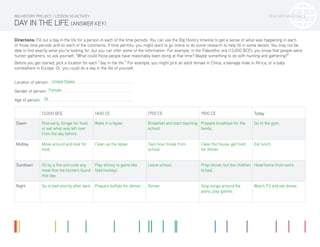
Lesson 9.0 Activity: A Day in the Life
- 1. TEACHER MATERIALS DAY IN THE LIFE (ANSWER KEY) Directions: Fill out a day in the life for a person in each of the time periods. You can use the Big History timeline to get a sense of what was happening in each of those time periods and on each of the continents. If time permits, you might want to go online to do some research to help fill in some details. You may not be able to find exactly what you’re looking for, but you can infer some of the information. For example, in the Paleolithic era (13,000 BCE), you know that people were hunter-gatherers, so ask yourself, “What could those people have reasonably been doing at that time? Maybe something to do with hunting and gathering?” Before you get started, pick a location for each “day in the life.” For example, you might pick an adult female in China, a teenage male in Africa, or a baby somewhere in Europe. Or, you could do a day in the life of yourself. Location of person: Gender of person: Age of person: 13,000 BCE 1400 CE 1750 CE 1900 CE Today Dawn Rise early, forage for food, or eat what was left over from the day before. Wake in a tepee. Breakfast and start teaching school. Prepare breakfast for the family. Go to the gym. Midday Move around and look for food. Clean up the tepee. Two-hour break from school. Clean the house, get food for dinner. Eat lunch. Sundown Sit by a fire and cook any meat that the hunters found that day. Play shinny (a game like field hockey). Leave school. Prep dinner, but the children to bed. Head home from work. Night Go to bed shortly after dark. Prepare buffalo for dinner. Dinner. Sing songs around the piano, play games. Watch TV and eat dinner. BIG HISTORY PROJECT / LESSON 9.0 ACTIVITY United States Female 36
- 2. Name: Date: STUDENT MATERIALS DAY IN THE LIFE Directions: Fill out a day in the life for a person in each of the time periods. You can use the Big History timeline to get a sense of what was happening in each of those time periods and on each of the continents. If time permits, you might want to go online to do some research to help fill in some details. You may not be able to find exactly what you’re looking for, but you can infer some of the information. For example, in the Paleolithic era (13,000 BCE), you know that people were hunter-gatherers, so ask yourself, “What could those people have reasonably been doing at that time? Maybe something to do with hunting and gathering?” Before you get started, pick a location for each “day in the life.” For example, you might pick an adult female in China, a teenage male in Africa, or a baby somewhere in Europe. Or, you could do a day in the life of yourself. Location of person: Gender of person: Age of person: 13,000 BCE 1400 CE 1750 CE 1900 CE Today Dawn Midday Sundown Night BIG HISTORY PROJECT / LESSON 9.0 ACTIVITY
